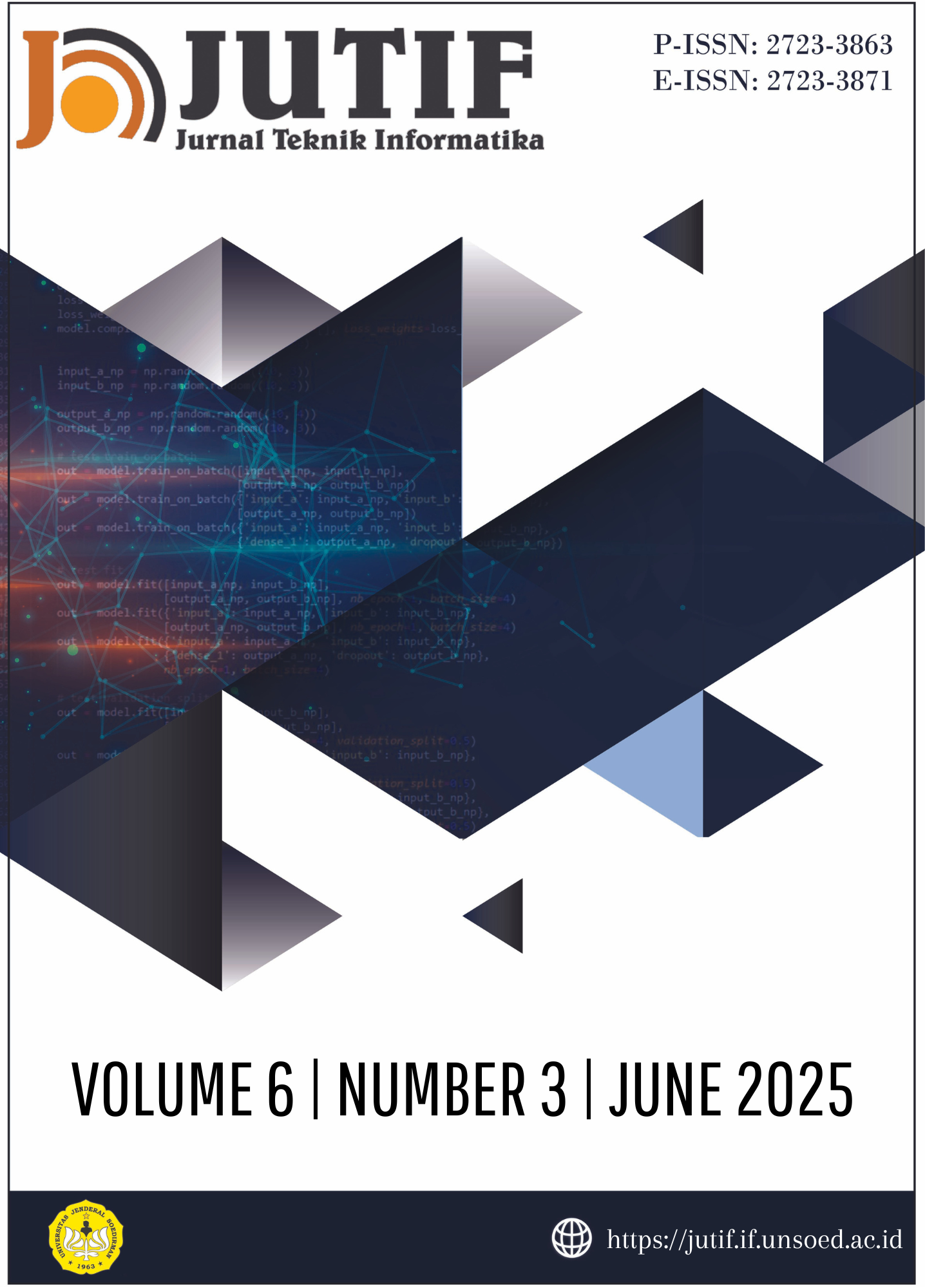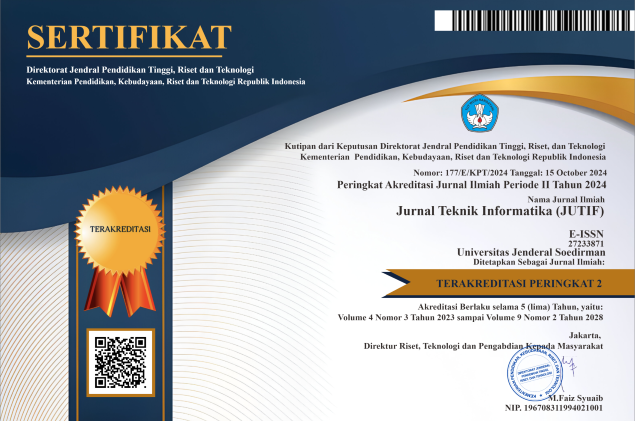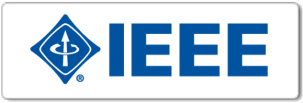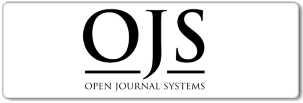Marketing Analysis of Shoe Products Using Principal Coordinates Analysis and K-Means Clustering Based on the Marketing Mix at Bintang Sepatu Purwokerto MSME
DOI:
https://doi.org/10.52436/1.jutif.2025.6.3.4687Keywords:
Clustering, K-Means, Marketing, PCoAAbstract
Bintang Sepatu Purwokerto MSME is a micro, small, and medium enterprise engaged in the production of local shoes. Recently, this MSME faced a significant issue in the marketing aspect, namely the low achievement of sales targets. Consequently, inventory will accumulate in the warehouse. Accordingly, this research aimed to formulate targeted marketing strategies by clustering customers based on demographic and marketing mix influencing purchasing behavior. This study applied principal coordinate analysis (PCoA) and k-means clustering to manage categorical and numerical data types within the dataset comprising 179 customers and 16 attributes.. The PCoA algorithm was utilized to derive object configurations that were subsequently employed in k-means. The clustering result produced three clusters with good clustering quality based on the Silhouette score, namely 0.790, indicating accurate and representative segmentation. Each cluster obtained had a different customer characteristic. The first cluster, comprising 68 customers (38%), was oriented towards fundamental needs and tended to shop traditionally, classified as a segment of conventional rational customers. Additionally, the second cluster, with 70 customers (39%), exhibited planned and stable decision-making, categorized as mature rational customers. Furthermore, the third cluster comprises 41 customers (23%) who are digitally aware and combine conventional shopping approaches with technological utilization, identified as rational consumers. The segmentation results provide a data-driven foundation for designing targeted marketing strategies, thereby potentially increasing sales, supporting the sustainability of MSMEs, and encouraging the application of unsupervised learning techniques in decision-making processes.
Downloads
References
A. Siburian and D. P. Ompusunggu, “Pengaruh Pertumbuhan Usaha Mikro, Kecil dan Menengah Terhadap Pertumbuhan Ekonomi Di Palangka Raya,” JUEB J. Ekon. dan Bisnis, vol. 2, no. 2, pp. 30–34, 2023, doi: 10.57218/jueb.v2i2.604.
Kominfo, “Transformasi Digital UMKM Jadi Prioritas Penguatan Fondasi Ekonomi,” Kominfo, 2022.
L. Yulia and W. Setianingsih, “Studi Manajemen Marketing Berbasis Online (Penelitian Pada Umkm Produksi Mebel Di Babakan Muncang Tamansari Kota Tasikmalaya),” J. Maneksi, vol. 9, no. 1, pp. 346–354, 2020, doi: 10.31959/jm.v9i1.397.
A. Septiana and Zulkifli, “Jurnal Riset Akuntansi dan Bisnis Jurnal Riset Akuntansi dan Bisnis,” Pengaruh Literasi Keuangan, Sikap Keuangan, dan Perilaku Pengelolaan Keuang. terhadap Kinerja UMKM, vol. 18, no. 2, pp. 140–152, 2024, doi: 10.17509/jrak.v11i3.52018.
A. Affandi et al., “Optimization of MSMEs empowerment in facing competition in the global market during the COVID-19 pandemic time,” Syst. Rev. Pharm., vol. 11, no. 11, pp. 1506–1515, 2020, doi: 10.31838/srp.2020.11.213.
C. Sianturi and J. M. Simanjuntak, “Pengaruh Strategi Pemasaran Terhadap Peningkatan Volume Penjualan Lahan Di Pt. Kawasan Industri Modern (Persero) Medan,” J. Ilmu Sos. Dan Polit., vol. 1, no. 2, pp. 205–224, 2021, doi: 10.51622/jispol.v1i2.418.
R. Ananda, “Silhouette Density Canopy K-Means for Mapping the Quality of Education Based on the Results of the 2019 National Exam in Banyumas Regency,” Khazanah Inform. J. Ilmu Komput. dan Inform., vol. 5, no. 2, pp. 158–168, 2019, doi: 10.23917/khif.v5i2.8375.
A. Sulistiyawati and E. Supriyanto, “Implementasi Algoritma K-means Clustring dalam Penetuan Siswa Kelas Unggulan,” J. Tekno Kompak, vol. 15, no. 2, p. 25, 2021, doi: 10.33365/jtk.v15i2.1162.
S. N. Br Sembiring, H. Winata, and S. Kusnasari, “Pengelompokan Prestasi Siswa Menggunakan Algoritma K-Means,” J. Sist. Inf. Triguna Dharma (JURSI TGD), vol. 1, no. 1, p. 31, 2022, doi: 10.53513/jursi.v1i1.4784.
S. K. Dirjen, P. Riset, D. Pengembangan, R. Dikti, R. Ananda, and A. Z. Yamani, “Penentuan Centroid Awal K-means pada proses Clustering Data Evaluasi Pengajaran Dosen,” Masa Berlaku Mulai, vol. 1, no. 3, pp. 544–550, 2017.
C. S. D. B. Sembiring, L. Hanum, and S. P. Tamba, “Penerapan Data Mining Menggunakan Algoritma K-Means Untuk Menentukan Judul Skripsi Dan Jurnal Penelitian (Studi Kasus Ftik Unpri),” J. Sist. Inf. dan Ilmu Komput. Prima(JUSIKOM PRIMA), vol. 5, no. 2, pp. 80–85, 2022, doi: 10.34012/jurnalsisteminformasidanilmukomputer.v5i2.2393.
R. Ananda, A. R. Dewi, and N. Nurlaili, “a Comparison of Clustering By Imputation and Special Clustering Algorithms on the Real Incomplete Data,” J. Ilmu Komput. dan Inf., vol. 13, no. 2, pp. 65–75, 2020, doi: 10.21609/jiki.v13i2.818.
R. Ananda and A. Prasetiadi, “Hierarchical and K-means Clustering in the Line Drawing Data Shape Using Procrustes Analysis,” Int. J. Informatics Vis., vol. 5, no. 3, pp. 306–312, 2021, doi: 10.30630/JOIV.5.3.532.
K. M. Daud, R. Ananda, S. Zainudin, C. W. Howe, K. Moorthy, and N. I. B. M. Saleh, “Optimizing the Production of Valuable Metabolites using a Hybrid of Constraint-based Model and Machine Learning Algorithms: A Review,” Int. J. Adv. Comput. Sci. Appl., vol. 14, no. 10, pp. 1091–1105, 2023, doi: 10.14569/IJACSA.2023.01410115.
X. F. Song, Y. Zhang, D. W. Gong, and X. Z. Gao, “A Fast Hybrid Feature Selection Based on Correlation-Guided Clustering and Particle Swarm Optimization for High-Dimensional Data,” IEEE Trans. Cybern., vol. 52, no. 9, pp. 9573–9586, 2022, doi: 10.1109/TCYB.2021.3061152.
E. F. L. Awalina and W. I. Rahayu, “Optimalisasi Strategi Pemasaran dengan Segmentasi Pelanggan Menggunakan Penerapan K-Means Clustering pada Transaksi Online Retail,” J. Teknol. dan Inf., vol. 13, no. 2, pp. 122–137, 2023, doi: 10.34010/jati.v13i2.10090.
M. F. Nugraha and U. Hayati, “Clustering Data Indonesian Food Delivery Menggunakan Metode K-Means Pada Gofood Product List,” vol. 8, no. 3, pp. 3484–3492, 2024, doi: 10.36040/jati.v8i3.9727.
A. Koroluk, E. Paczos-Grzęda, S. Sowa, M. Boczkowska, and J. Toporowska, “Diversity of Polish Oat Cultivars with a Glance at Breeding History and Perspectives,” Agronomy, vol. 12, no. 10, 2022, doi: 10.3390/agronomy12102423.
D. Hediyati and I. M. Suartana, “Penerapan Principal Component Analysis (PCA) Untuk Reduksi Dimensi Pada Proses Clustering Data Produksi Pertanian Di Kabupaten Bojonegoro,” J. Inf. Eng. Educ. Technol., vol. 5, no. 2, pp. 49–54, 2021, doi: 10.26740/jieet.v5n2.p49-54.
S. Saniah and Edy Victor Haryanto, “Rancang Bangun Aplikasi Pencarian Lokasi Vaksin Pada Puskesmas Di Kota Medan Menggunakan Metode Euclidean Distance Berbasis Android,” J. Ilm. Sist. Inf. dan Ilmu Komput., vol. 3, no. 1, pp. 01–11, 2023, doi: 10.55606/juisik.v3i1.365.
R. Ananda, K. M. Daud, and S. Zainudin, “A review of advances in integrating gene regulatory networks and metabolic networks for designing strain optimization,” J. King Saud Univ. - Comput. Inf. Sci., vol. 36, no. 6, p. 102120, 2024, doi: 10.1016/j.jksuci.2024.102120.
S. Dhau, R. Ananda, I. Nurisusilawati, N. Afrina, H. Zulkarnain, and J. Tengah, “Optimasi Rute Distribusi Frozen Food Menggunakan Metode Principal Coordinate Analysis Dan Nearest Neighbor,” vol. 1, pp. 162–170, 2024, doi: 10.61124/sinta.v1i4.34.
S. Sucipto, D. Dwi Prasetya, and T. Widiyaningtyas, “Educational Data Mining: Multiple Choice Question Classification in Vocational School,” MATRIK J. Manajemen, Tek. Inform. dan Rekayasa Komput., vol. 23, no. 2, pp. 379–388, 2024, doi: 10.30812/matrik.v23i2.3499.
C. Gower, J, “A general coefficient of similarity and some of its properties.,” Biometrics, vol. 27, no. 4, pp. 857–871, 1971, [Online]. Available: https://www.jstor.org/stable/2528823
I. Fadil, R. Goejantoro, and S. Prangga, “Aplikasi K-Nearest Neighbor Dengan Fungsi Jarak Gower Dalam Klasifikasi Kelulusan Mahasiswa (Studi Kasus : Mahasiswa Program Studi Statistika, Jurusan Matematika, Fakultas Matematika Dan Ilmu Pengetahuan Alam, Universitas Mulawarman),” J. EKSPONENSIAL, vol. 13, no. 1, pp. 57–62, 2022, doi: 10.30872/eksponensial.v13i1.881.
I. Izzati, D. Yusuf, B. Susetyo, and L. O. Abdul, “Perbandingan Metode Hot-deck , Regression dan K-Nearest,” vol. 12, no. 1, pp. 22–35, 2023, doi: 10.29244/xplore.v12i1.1056.
A. Winarta and W. J. Kurniawan, “Optimasi Cluster K-Means Menggunakan Metode Elbow Pada Data Pengguna Narkoba Dengan Pemrograman Python,” JTIK (Jurnal Tek. Inform. Kaputama), vol. 5, no. 1, pp. 113–119, 2021, doi: 10.59697/jtik.v5i1.593.
A. Yudhistira and R. Andika, “Pengelompokan Data Nilai Siswa Menggunakan Metode K-Means Clustering,” J. Artif. Intell. Technol. Inf., vol. 1, no. 1, pp. 20–28, 2023, doi: 10.58602/jaiti.v1i1.22.
L. G. Rady Putra and A. Anggrawan, “Pengelompokan Penerima Bantuan Sosial Masyarakat dengan Metode K-Means,” MATRIK J. Manajemen, Tek. Inform. dan Rekayasa Komput., vol. 21, no. 1, pp. 205–214, 2021, doi: 10.30812/matrik.v21i1.1554.
A. P. Riani, A. Voutama, and T. Ridwan, “Penerapan K-Means Clustering Dalam Pengelompokan Hasil Belajar Peserta Didik Dengan Metode Elbow,” J-SISKO TECH (Jurnal Teknol. Sist. Inf. dan Sist. Komput. TGD), vol. 6, no. 1, p. 164, 2023, doi: 10.53513/jsk.v6i1.7351.
R. Bayu Prasetyo, Y. Agus Pranoto, and R. Primaswara Prasetya, “Implementasi Data Mining Menggunakan Algoritma K-Means Clustering Penyakit Pasien Rawat Jalan Pada Klinik Dr. Atirah Desa Sioyong, Sulteng,” JATI (Jurnal Mhs. Tek. Inform., vol. 7, no. 4, pp. 2144–2151, 2023, doi: 10.36040/jati.v7i4.7419.
M. S. Pangestu and M. A. Fitriani, “Perbandingan Perhitungan Jarak Euclidean Distance, Manhattan Distance, dan Cosine Similarity dalam Pengelompokan Data Bibit Padi Menggunakan Algoritma K-Means,” Sainteks, vol. 19, no. 2, p. 141, 2022, doi: 10.30595/sainteks.v19i2.14495.
M. S. Abidin et al., “Application of the DBSCAN Algorithm in MSME Clustering using the Silhouette Coefficient Method,” vol. 07, no. 03, pp. 260–270, 2024, doi: https://doi.org/10.37396/jsc.v7i3.472.
M. Taufiqurrochman, W. Khristianto, and E. Wahyudi, “Implementasi Bauran Pemasaran Pada Kopixel Jember,” J. Ilm. Manaj. dan Bisnis, vol. 3, no. 1, pp. 1–12, 2024, doi: 10.24034/jimbis.v3i1.6075.
S. Wang, L. Sun, and Y. Yu, “A dynamic customer segmentation approach by combining LRFMS and multivariate time series clustering,” Sci. Rep., vol. 14, no. 1, pp. 1–18, 2024, doi: 10.1038/s41598-024-68621-2.
Additional Files
Published
How to Cite
Issue
Section
License
Copyright (c) 2025 Samuel Sinaga, Ridho Ananda , Halim Qista Karima, Adrus Mohamad Tazuddin

This work is licensed under a Creative Commons Attribution 4.0 International License.



























